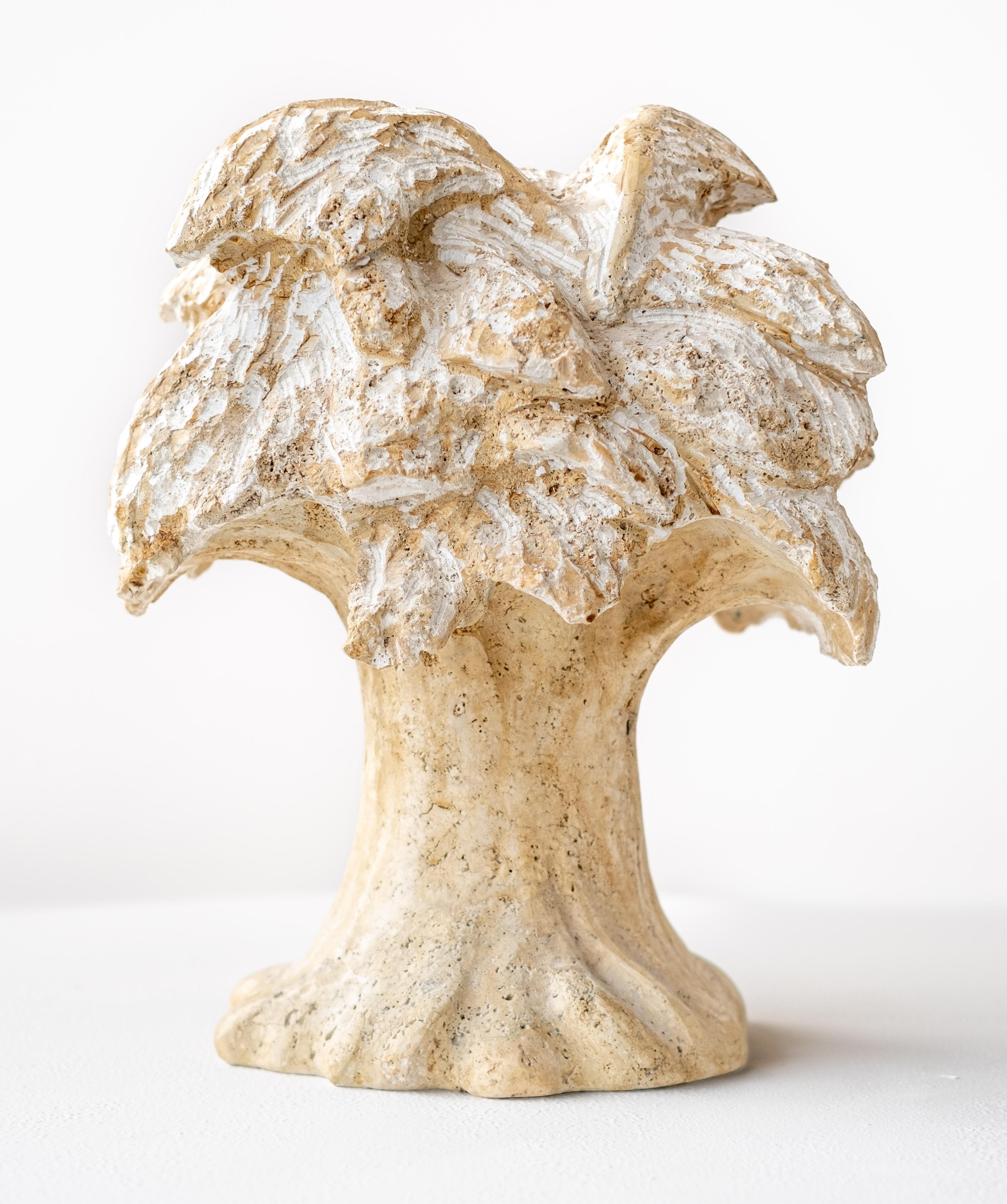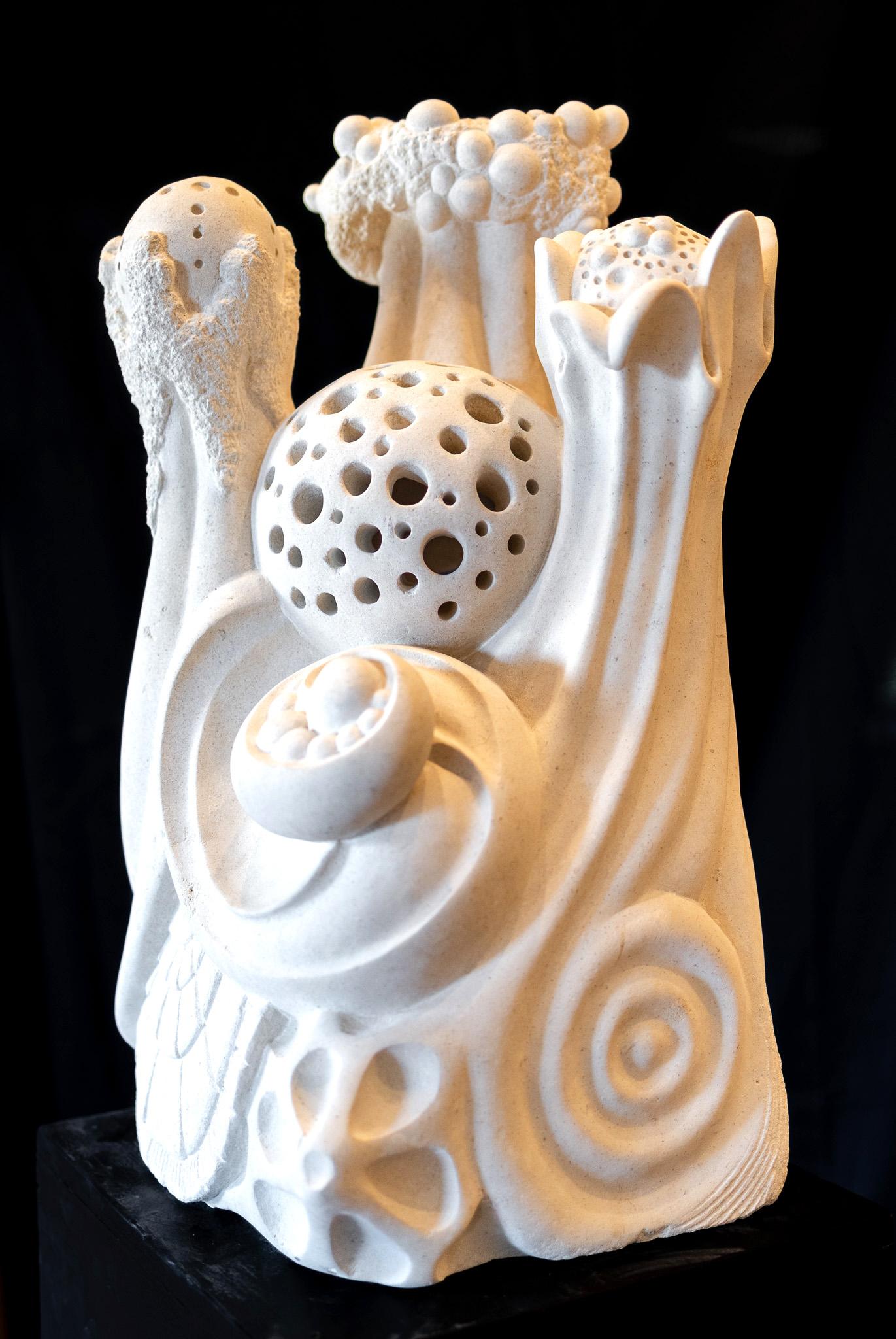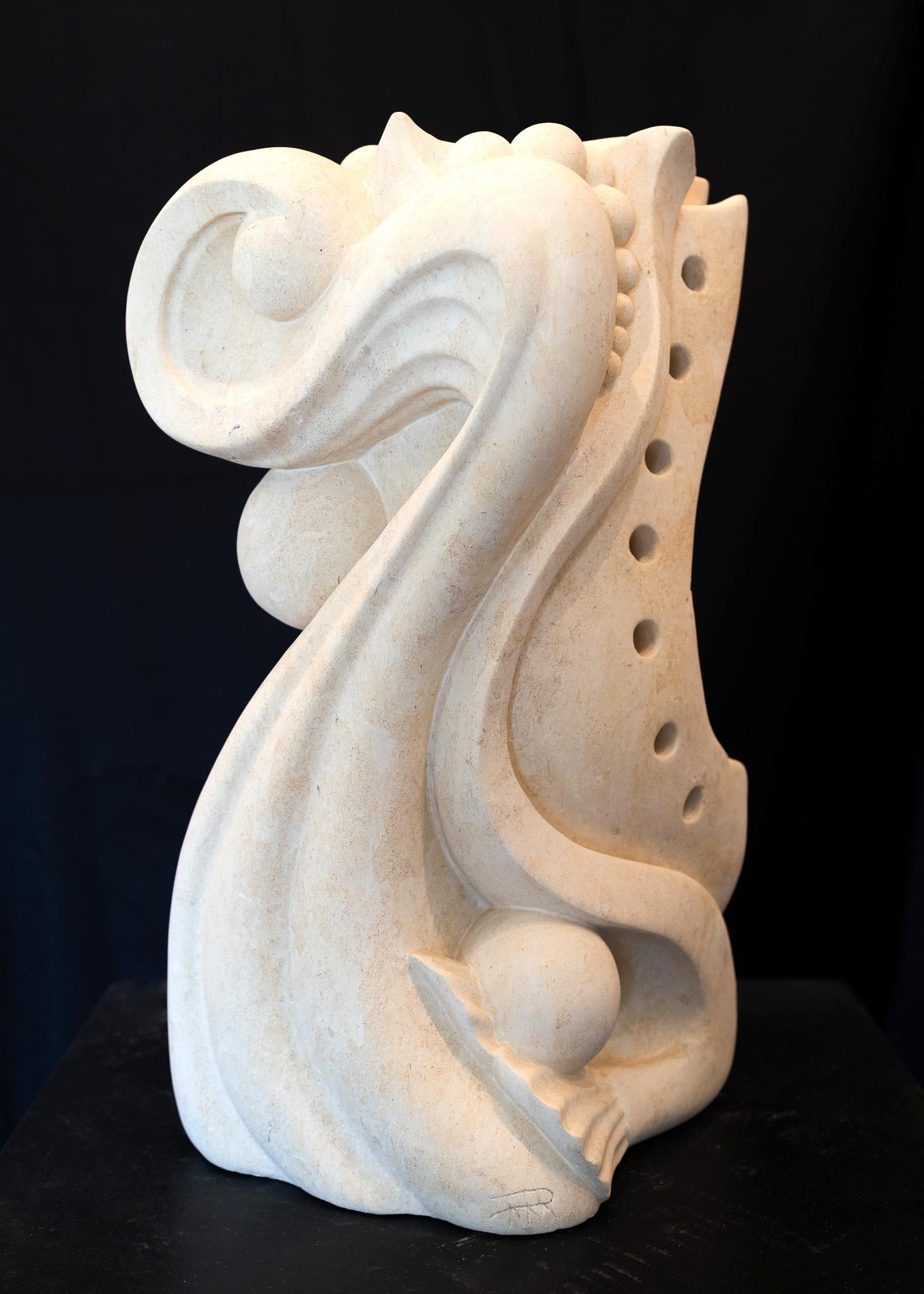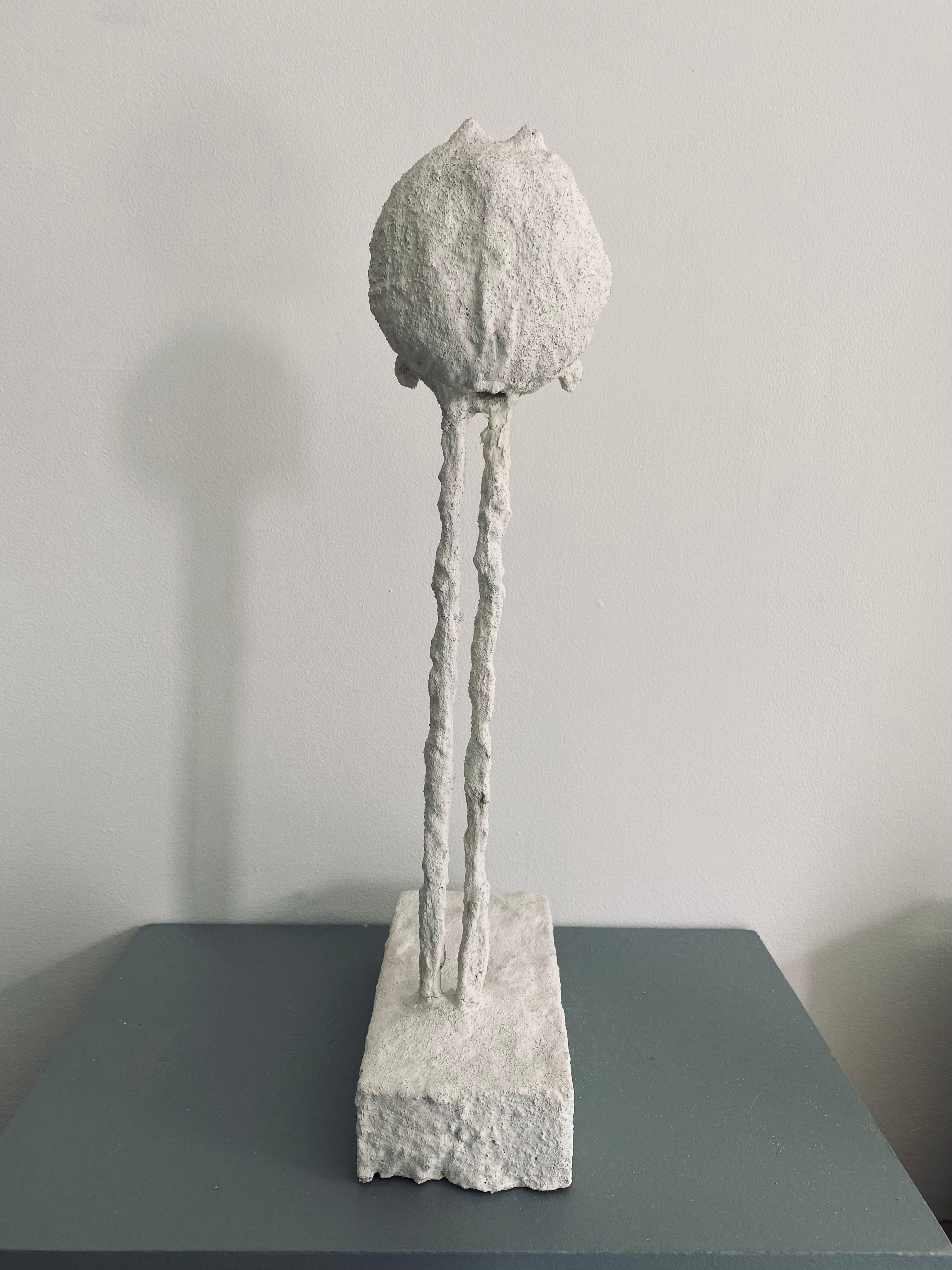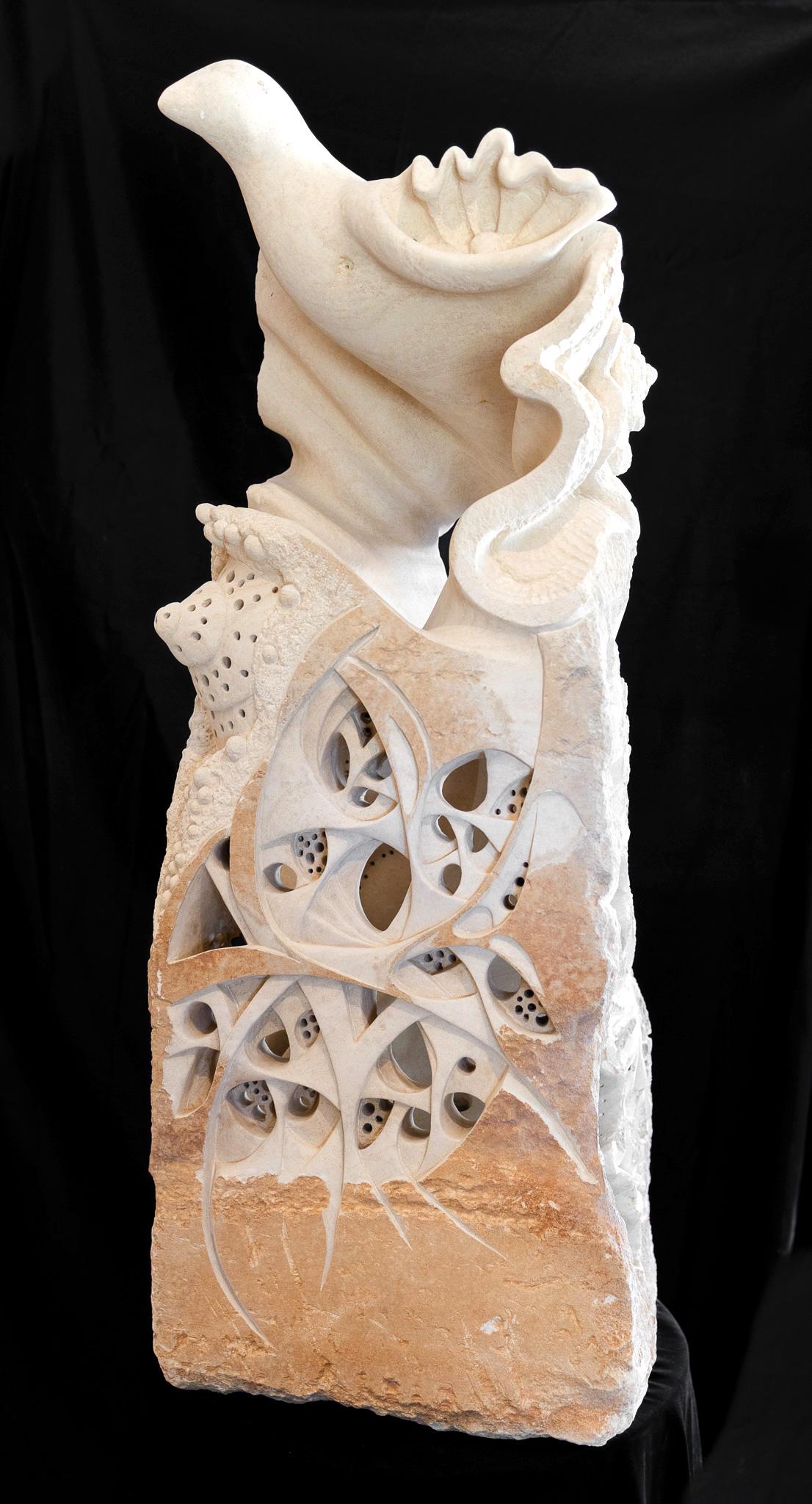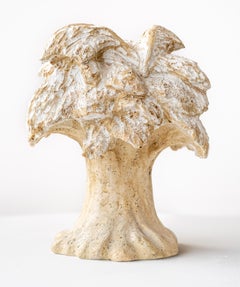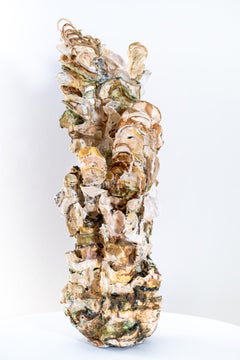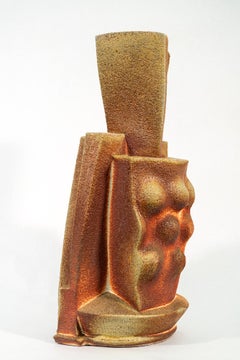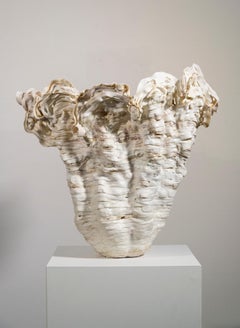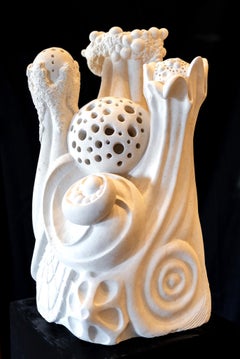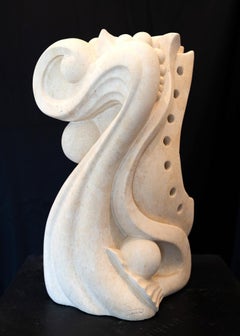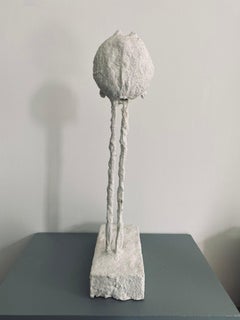Items Similar to Anemone Tower - abstract, contemporary, travertine stone, limestone, sculpture
Video Loading
Want more images or videos?
Request additional images or videos from the seller
1 of 15
Doug RobinsonAnemone Tower - abstract, contemporary, travertine stone, limestone, sculpture2018
2018
$5,200
£3,924.30
€4,492.73
CA$7,333.72
A$8,051.51
CHF 4,200.49
MX$97,434.53
NOK 52,646.65
SEK 49,606.99
DKK 33,537.01
About the Item
Inspired by the intriguing natural form of a sea creature called an anemone, Doug Robinson created this table top sculpture from a piece of Roman Travertine marble.
The anemone is named after a flower whose form it resembles. Robinson’s interpretation of the cylindrical tentacles is a faithful representation of the creature’s shape. The pitted and marked nature of the creamy-coloured marble enhances the organic form that sits on a marble ‘tower.’
As a young man, Robinson first came to Italy to train with master sculptors in the 1970s. Since then, the Canadian artist has lived and worked in a studio nestled amidst olive groves and next to the mountains where the famous Carrera marble is found.
“I get the stone and then I decide—(what it will become). I might make the odd sketch in my head. ” Doug Robinson
Doug Robinson studied sculpture at the Ontario College of Art and Design, the University of Guelph and in Italy. His work—sculptures in limestone, travertine and marble have been exhibited in France, Germany, London, Montreal and Prince Edward County, Ontario.
About the Seller
4.9
Recognized Seller
These prestigious sellers are industry leaders and represent the highest echelon for item quality and design.
Platinum Seller
Premium sellers with a 4.7+ rating and 24-hour response times
Established in 2004
1stDibs seller since 2013
372 sales on 1stDibs
Typical response time: 2 hours
- ShippingRetrieving quote...Shipping from: Bloomfield, Canada
- Return Policy
Authenticity Guarantee
In the unlikely event there’s an issue with an item’s authenticity, contact us within 1 year for a full refund. DetailsMoney-Back Guarantee
If your item is not as described, is damaged in transit, or does not arrive, contact us within 7 days for a full refund. Details24-Hour Cancellation
You have a 24-hour grace period in which to reconsider your purchase, with no questions asked.Vetted Professional Sellers
Our world-class sellers must adhere to strict standards for service and quality, maintaining the integrity of our listings.Price-Match Guarantee
If you find that a seller listed the same item for a lower price elsewhere, we’ll match it.Trusted Global Delivery
Our best-in-class carrier network provides specialized shipping options worldwide, including custom delivery.More From This Seller
View AllNoce - figurative, flora, hand-carved, Sienna Travertine stone sculpture
By Douglas Robinson
Located in Bloomfield, ON
Hand carved from the richly marked cream-coloured Sienna Travertine marble, this contemporary tabletop sculpture of a walnut tree is by Doug Robinson. Th...
Category
2010s Contemporary Figurative Sculptures
Materials
Limestone
Traverse - contemporary, abstract, hand-sculpted, ceramic tabletop sculpture
By Susan Collett
Located in Bloomfield, ON
This stunning contemporary vessel was hand-built from clay by Susan Collett.
Her intricately detailed vessels are sculptural and created by twisting, squeezing and shaping paper cla...
Category
2010s Contemporary Abstract Sculptures
Materials
Ceramic
Stacked Vessel Wood Fired - abstract, glazed, ceramic, vessel sculpture
Located in Bloomfield, ON
This unique contemporary ceramic vessel is by Bruce Cochrane.
The striking clay artwork of this Canadian artist has garnered him international attention, including several nominatio...
Category
2010s Abstract Abstract Sculptures
Materials
Ceramic
Gleam - contemporary, hand-sculpted, cream, porcelain sculpture
By Susan Collett
Located in Bloomfield, ON
This contemporary sculptural indoor porcelain vessel was made by Susan Collett.
The exquisite hand-built porcelain vessels of Susan Collett have garnered her international praise an...
Category
2010s Contemporary Abstract Sculptures
Materials
Porcelain
Untitled No.36, Contour - minimalist, abstract, contemporary ceramic sculpture
By Jana Osterman
Located in Bloomfield, ON
This abstract ceramic indoor sculpture was inspired by nature.
The enigmatic and compelling ceramics by Canadian artist Jana Osterman are influenced in form, pattern, texture, and c...
Category
2010s Contemporary Abstract Sculptures
Materials
Ceramic
Laurel II - hand sculpted, cream, coral, dynamic, earthenware, ceramic
By Susan Collett
Located in Bloomfield, ON
Sculpted of earthenware paper clay, this dynamic work by Canadian artist Susan Collett is multi-fired to achieve complex surfaces. The work is rich with craquelure in hues of blue, p...
Category
2010s Abstract Abstract Sculptures
Materials
Ceramic
You May Also Like
"Aria" Psychedelic Carved Stone Sculpture White Abstract Sphere Waves Bubbles
Located in Austin, TX
By Bob Ragan
White Limestone from Florence, Texas
24" x 13" x 13"
275 lbs
Category
21st Century and Contemporary Abstract Sculptures
Materials
Limestone
"Seven Sisters" Fantastical Psychedelic Sculpture White Limestone Stone Carving
Located in Austin, TX
By Bob Ragan
25" x 12" x 12"
Texas Limestone
250 lbs
About the Artist:
Bob Ragan is a nationally recognized master stone carver who has spent a lifetime stu...
Category
21st Century and Contemporary Abstract Sculptures
Materials
Limestone
Cement Totem: 'The Tribe #26'
By Ivy Naté
Located in New York, NY
‘The tribe serves as a sacred narrative of a time passed that I have chosen to birth anew. . Each one of my pieces carries the love of thousands, those who came before us and those w...
Category
2010s Contemporary Figurative Sculptures
Materials
Mixed Media
Arise. Stone mass, porcelain, h 57 cm; W 21 cm; D 25 cm
Located in Riga, LV
Arise. Stone mass, porcelain, h 57 cm; W 21 cm; D 25 cm
White abstract sculpture from stone mass
Category
2010s Abstract Abstract Sculptures
Materials
Stone
$3,082 Sale Price
20% Off
"Sea Candy" Psychedelic Sculpture White Limestone Stone Carving by Bob Ragan
Located in Austin, TX
By Bob Ragan
49" x 17" x 17"
Texas Limestone
600 lbs
About the Artist:
Bob Ragan is a nationally recognized master stone carver who has spent a lifetime studying art and architecture. During extensive travels throughout Europe and Central America, he researched the works and carving techniques of Old World masters.
Ragan and his partner Mary Condon founded the architectural and sculpture stone-carving firm Texas Carved Stone forty years ago. As a member of the National Stone Carvers’ Guild, he regularly teaches stone carving classes and mentors young people in the field.
Ragan's sculptures communicate a deep sense of spontaneity, originality, and creativity. He transfigures large blocks of stone into intricate designs that feel remarkably buoyant and often contain humorous elements.
Bob Ragan has been featured in numerous local publications, and state and national publications including Fine Homebuilding (June/July 1989), Southern Living (November 1991), Building Stone Magazine (Winter 2005), Tex Appeal (December 2012), the San Antonio Express News (June 5, 2005), the Dallas Morning News (May 20, 2003), the Texas Monthly (July 1996, July 1998), the Indiana Limestone Symposium, Stone World, Masonry Magazine, and Stone Update. A show about Ragan and his work is considered by the Texas Country...
Category
21st Century and Contemporary Abstract Sculptures
Materials
Limestone
"VERTICAL 7", sculpture, clay, ceramic, abstract, tribal, pattern, tower, column
By Harold Wortsman
Located in Toronto, Ontario
Vertical 7, a ceramic sculpture of wood-fired clay pigmented with oxides, is a work by New York artist Harold Wortsman. Vertical 7 was recently exhibited at "Harold Wortsman: Time and Space" at the Orange Art Foundation, February-March 2022, New York City.
Note the blending of geometric and organic forms in this work – it is characteristic of his practice – warm, contemporary, uniquely crafted, yet speaks to ancient, primitive traditions of art-making that cross cultures and histories. Highly attuned to the art of Africa, the Middle East, India and Asia, his forms are organic abstracts with masculine and feminine attributes that resonate together as a pleasing enigma. They make sense immediately, yet never give up all their secrets.
From Harold Wortsman – "With sculpture, my material of choice is high-fired clay. Pieces are first low-fired in an electric kiln. I do not use glazes. Instead, I use oxides applied to the bisqued (low-fired) clay. As with a tattoo, oxides permit the surface underneath to breathe. The work is then high-fired in a gas kiln with double reduction to cone 10. The final temperature is 2,300 degrees F. At a certain point, oxygen intake is reduced to the kiln. Because the fire has reached a critical mass, it needs oxygen and chemically takes it from the clay and the oxides. Like a jazz improvisation, each kiln load comes out slightly different."
From Jonathan Goodman – "Wortsman has increasingly moved into his own – a place in which the relations between the abstractions of volume and the intimations of very old culture are merged in a way that is new." – Essay, "Harold Wortsman: Time and Space", Orange Art Foundation, February 2022, New York City.
Harold Wortsman is a sculptor and printmaker based in Brooklyn, NY. He “creates forms that bring to mind archaic cult objects and exude a quiet concentrated strength.” (Argauer Zeitung, Switzerland). His work, an edgy mix of freedom and clarity, can be found in public and private collections in the US, including The Library of Congress, Yale University, The New York Public Library Print Collection, The New York Historical Society, Smith College, Indiana University’s Lilly Library, Brandeis University, The Newark Public Library Special Collections Division, and the Jane Voorhees Zimmerli Art Museum Print Archive. Also in private and public collections in Europe, including the Municipal Collection of the City of Brugg, Switzerland.
Harold studied at the New York Studio School of Drawing, Painting and Sculpture, with sculptor George Spaventa...
Category
21st Century and Contemporary Contemporary Abstract Sculptures
Materials
Ceramic, Clay, Pigment, Other Medium
More Ways To Browse
Limestone Art
Marble Man
Sea Anemone
Rosenthal Louise
Salvador Dali Menorah
Sergio Bautista De La Cruz
Spoon Chandelier
Tammy Garcia
Vasarely Zebra Sculpture
Wendy Froud
Wilson Vase Stoneware
Wyatt Kahn
Zoe Greene Mercier
Abstract Sculptures Chandler Mclellan
African Granite Sculpture
Ahmed Faig
Anya Pesce
Appalachian Folk Art
